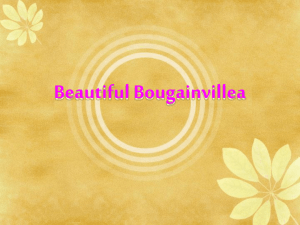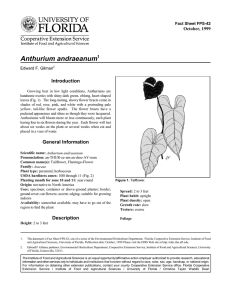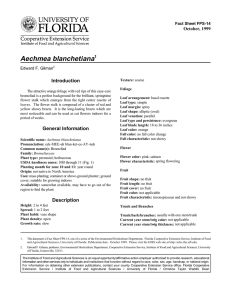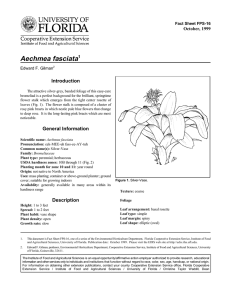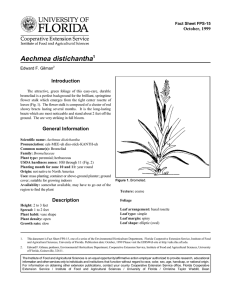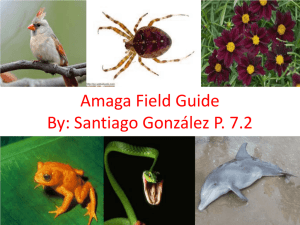Bougainvillea spp. Introduction October, 1999 Fact Sheet FPS-70
advertisement
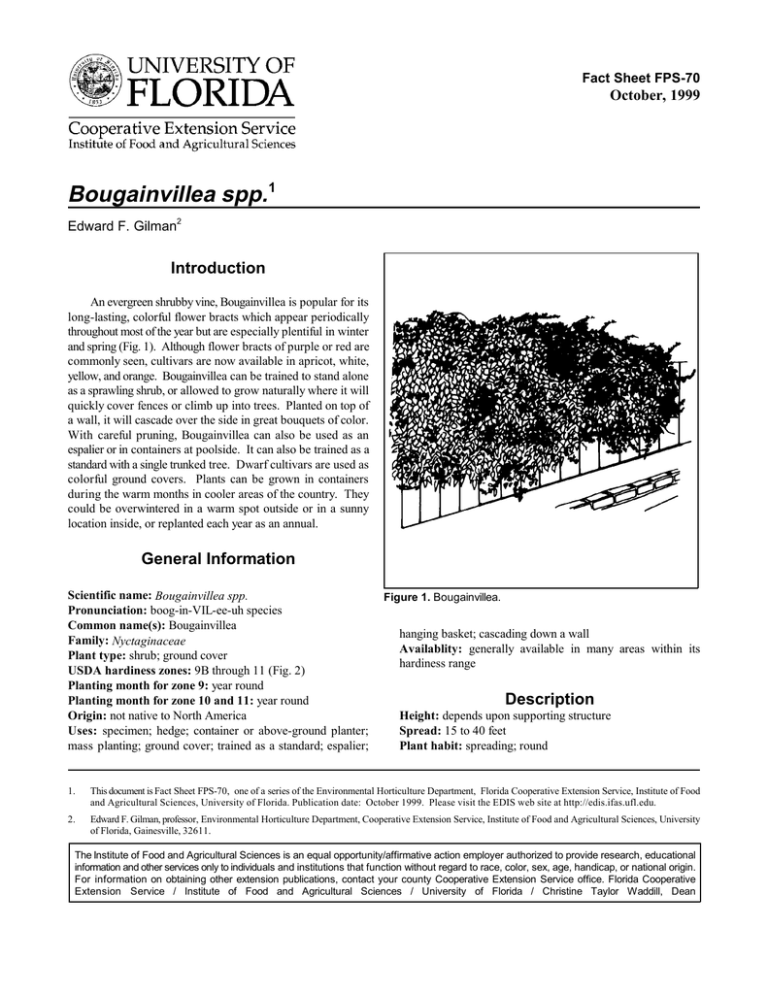
Fact Sheet FPS-70 October, 1999 Bougainvillea spp.1 Edward F. Gilman2 Introduction An evergreen shrubby vine, Bougainvillea is popular for its long-lasting, colorful flower bracts which appear periodically throughout most of the year but are especially plentiful in winter and spring (Fig. 1). Although flower bracts of purple or red are commonly seen, cultivars are now available in apricot, white, yellow, and orange. Bougainvillea can be trained to stand alone as a sprawling shrub, or allowed to grow naturally where it will quickly cover fences or climb up into trees. Planted on top of a wall, it will cascade over the side in great bouquets of color. With careful pruning, Bougainvillea can also be used as an espalier or in containers at poolside. It can also be trained as a standard with a single trunked tree. Dwarf cultivars are used as colorful ground covers. Plants can be grown in containers during the warm months in cooler areas of the country. They could be overwintered in a warm spot outside or in a sunny location inside, or replanted each year as an annual. General Information Scientific name: Bougainvillea spp. Pronunciation: boog-in-VIL-ee-uh species Common name(s): Bougainvillea Family: Nyctaginaceae Plant type: shrub; ground cover USDA hardiness zones: 9B through 11 (Fig. 2) Planting month for zone 9: year round Planting month for zone 10 and 11: year round Origin: not native to North America Uses: specimen; hedge; container or above-ground planter; mass planting; ground cover; trained as a standard; espalier; Figure 1. Bougainvillea. hanging basket; cascading down a wall Availablity: generally available in many areas within its hardiness range Description Height: depends upon supporting structure Spread: 15 to 40 feet Plant habit: spreading; round 1. This document is Fact Sheet FPS-70, one of a series of the Environmental Horticulture Department, Florida Cooperative Extension Service, Institute of Food and Agricultural Sciences, University of Florida. Publication date: October 1999. Please visit the EDIS web site at http://edis.ifas.ufl.edu. 2. Edward F. Gilman, professor, Environmental Horticulture Department, Cooperative Extension Service, Institute of Food and Agricultural Sciences, University of Florida, Gainesville, 32611. The Institute of Food and Agricultural Sciences is an equal opportunity/affirmative action employer authorized to provide research, educational information and other services only to individuals and institutions that function without regard to race, color, sex, age, handicap, or national origin. For information on obtaining other extension publications, contact your county Cooperative Extension Service office. Florida Cooperative Extension Service / Institute of Food and Agricultural Sciences / University of Florida / Christine Taylor Waddill, Dean Bougainvillea spp. -- Bougainvillea Page 2 Figure 2. Shaded area represents potential planting range. Plant density: moderate Growth rate: fast Texture: medium Fruit length: less than .5 inch Fruit cover: dry or hard Fruit color: unknown Fruit characteristic: inconspicuous and not showy Foliage Trunk and Branches Leaf arrangement: alternate Leaf type: simple Leaf margin: undulate Leaf shape: ovate Leaf venation: pinnate Leaf type and persistence: evergreen Leaf blade length: 2 to 4 inches Leaf color: variegated Fall color: no fall color change Fall characteristic: not showy Flower Flower color: purple; red; lavender; yellow Flower characteristic: flowers periodically throughout the year Trunk/bark/branches: not particularly showy; can be trained to grow with a short, single trunk; typically multi-trunked or clumping stems Current year stem/twig color: brown Current year stem/twig thickness: thin Culture Light requirement: plant grows in full sun Soil tolerances: clay; sand; acidic; slightly alkaline; loam Drought tolerance: high Soil salt tolerances: unknown Plant spacing: 36 to 60 inches Fruit Fruit shape: elongated October 1999 Bougainvillea spp. -- Bougainvillea Page 3 Other Roots: not applicable Winter interest: plant has winter interest due to unusual form, nice persistent fruits, showy winter trunk, or winter flowers Outstanding plant: plant has outstanding ornamental features and could be planted more Invasive potential: not known to be invasive Pest resistance: long-term health usually not affected by pests Use and Management Growing best in full sun or light shade on well-drained, acid soils, Bougainvillea can tolerate hot, dry locations fairly well but flowers bountifully in full sun with regular watering. Chlorosis can be a problem in alkaline soil. Regular pruning may be necessary to shape the plant or direct its growth since shoots often grow vigorously, but Bougainvillea tolerates trimming well. These vigorous shoots can stunt growth on the rest of the plant if they are left to develop. Be careful when trimming to avoid injury from the 1 to 2-inch-long thorns. This is generally a low-maintenance plant. Figure 3. Foliage of Bougainvillea Plants often loose many leaves following a flowering period. This usually preceeds a new growth flush. Available cultivars include: ‘Barbara Karst’, bright red bracts, vigorous growth; ‘Afterglow’, yellow-orange, heavy bloom, sparse foliage; `Hawaii’ (‘Raspberry Ice’), red bloom, leaves have golden yellow margins, is one of the hardiest. Dwarf cultivars include: ‘Crimson Jewel’, combines crimson, pink, and orange; ‘Oo-la-la’, very purple. There is also a cultivar available with variegated foliage, ‘Variegata’. Bougainvillea spectabilis has purple-red flower bracts, thorny stems, leaves thick, large, and hairy. Bougainvillea glabra has smooth leaves, rose-red flower bracts, is less thorny, and is hardier. Propagation is by seeds or cuttings. Pests and Diseases No pests or diseases are of major concern but occasionally leaf-chewing worms or aphids. October 1999
